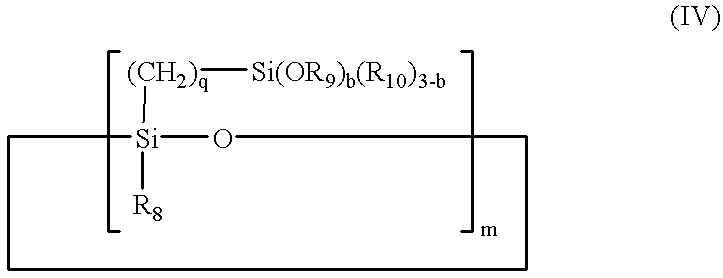Method for coating carrier particles
a carrier particle and coating technology, applied in the field of coating carrier particle methods, can solve the problems of large air pollution, large installation cost, damage to the coating around the carrier particle, etc., and achieve the effect of simple, fast and reliabl
- Summary
- Abstract
- Description
- Claims
- Application Information
AI Technical Summary
Benefits of technology
Problems solved by technology
Method used
Image
Examples
invention example 1
[0099] The same composition as given in table 1 was prepared, except for the amount of isopropanol which now was 113 g per 1000 g of carrier particles instead of 29.3 g and no nitrogen containing charge controller was present. 7,500 g Cu--Zn-Ferrite carrier particles, i.e. a volume A of 1,470 ml, as used in comparative example 1, were stirred in a vessel at room temperature (about 25.degree. C.). The coating solution of 941 g, comprising a volume B of 1,080 ml of solvent, was added at once, without any pre-reaction. Under continuous stirring the carrier particles and coating solution were gradually heated to a temperature of 80 degrees C over 1 hour thereby slowly evaporating the solvent. After the removal of the solvent, the coated carrier particles were subjected to a post-treatment wherein the temperature of the coated carrier particles was raised to 140.degree. C. while stirring intermittently in order to harden the coating.
invention example 2 (
IE2)
[0100] Invention example 2 is executed using the same procedure as in Invention example 1 except for the presence of 0.155 g nitrogen containing charge controller added to the solution after the addition of the isopropanol.
[0101] Measurement of the Quality of rhe Coating
[0102] Uncoated as well as coated carrier particles, i.e. coated as described in the different afore-mentioned examples, were measured with XPS (X-ray photoelectron spectroscopy) to evaluate the amount of metal atoms that reside at the surface. The carrier particles used were Zn--Cu ferrite particles. The results from XPS, as in Table 2, are a measure for the quality of the coating, as the lower the amount of metals at the surface, the better the coating.
2 TABLE 2 Cu Zn Fe [%] [%] [%] Non-coated 1.1 1.7 16.1 carrier core Comparative 0.1 0.3 2.6 example Invention -- -- 0.2 example 1 Invention -- -- 0.2 example 2
[0103] It is clear that the quality of the coating using the method of the invention is superior to the ...
PUM
 Login to View More
Login to View More Abstract
Description
Claims
Application Information
 Login to View More
Login to View More - R&D
- Intellectual Property
- Life Sciences
- Materials
- Tech Scout
- Unparalleled Data Quality
- Higher Quality Content
- 60% Fewer Hallucinations
Browse by: Latest US Patents, China's latest patents, Technical Efficacy Thesaurus, Application Domain, Technology Topic, Popular Technical Reports.
© 2025 PatSnap. All rights reserved.Legal|Privacy policy|Modern Slavery Act Transparency Statement|Sitemap|About US| Contact US: help@patsnap.com

